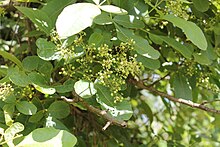ar
الأسماء في صفحات التنقل


Toxicodendron parviflorum commonly known as small-flowered poison sumac is a much-branched shrub bearing stalked leaves with three leaflets; the end leaflet is larger than the other two. The leaflets are obovate, with rounded tips, tapering bases and irregularly toothed margins. The flowers are tiny, yellowish and fragrant. The fruit is small, round and red when ripe. T. parviflorum is found in the Himalayas, from Kumaun to Bhutan, at altitudes of 700–1,100 metres (2,300–3,600 ft).[1]
 Toxicodendron parviflorum fruit
Toxicodendron parviflorum fruit Toxicodendron parviflorum commonly known as small-flowered poison sumac is a much-branched shrub bearing stalked leaves with three leaflets; the end leaflet is larger than the other two. The leaflets are obovate, with rounded tips, tapering bases and irregularly toothed margins. The flowers are tiny, yellowish and fragrant. The fruit is small, round and red when ripe. T. parviflorum is found in the Himalayas, from Kumaun to Bhutan, at altitudes of 700–1,100 metres (2,300–3,600 ft).